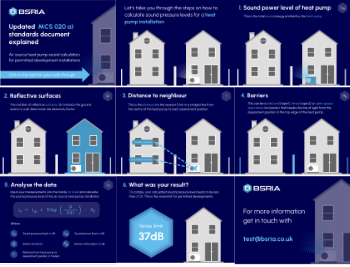Heat source
Heat is the energy that is transferred between different systems as a result of thermodynamic interactions. Heat differs from temperature, which is a measure of the average kinetic energy of molecules. Temperature will tend to vary throughout a body depending on its heat exchange with its surroundings
In the built environment, heat may be used to:
- Create comfortable conditions for occupants.
- To prevent condensation.
- For activities such as drying and cooking.
- For industrial processes.
A heat source is a system from which heat is ‘lost’ to a heat sink. For example, in the built environment, a radiator may be considered to be a heat source, whilst the space around it, which it heats by a process of radiation and convection, might be considered to be a heat sink.
Heat sinks might also refer more specifically to active devices that transfer heat from a system to a medium that dissipates that heat away from the system, and in so doing cooling it. Heat sink devices are commonly used to cool computers.
Anything may behave as either a heat source or a heat sink depending on its temperature compared to its surroundings, however, in the building environment a number of elements are exploited specifically for their characteristics as heat sources for functions such as helping create thermal comfort.
This might include:
- The sun.
- The ground (eg ground source heat pumps, geothermal piles).
- The air (eg air source heat pumps).
- Water (eg water source heat pumps).
- Thermal mass (such as an exposed concrete slab).
- Heating devices such as radiators, electric heaters, open fires, wood-burning stoves and so on.
Other items might act as inadvertent heat sources, which may not be desirable as they may cause overheating, such as people, computers, ovens and other equipment. These heat sources are sometimes referred to as heat loads.
Heat sinks might include air conditioning systems, refrigeration equipment, thermal mass and so on.
Heat sources and heat sinks such as thermal mass might be described as ‘passive’ in that they use the layout, fabric and form of a building to reduce or remove the need for ‘active’ systems such as heating, ventilation and air conditioning systems.
[edit] Related articles on Designing Buildings
- Boiler.
- Building heating systems.
- Conduction.
- Convection.
- Ground source heat pumps.
- Heat.
- Heat interface units.
- Heat meter.
- Heat pump.
- Heat recovery.
- Heat transfer.
- National heat map.
- Overheating.
- Radiant heating.
- Radiation.
- Solar gain.
- Thermal comfort.
- Thermal mass.
- Types of domestic heating system.
Featured articles and news
Gregor Harvie argues that AI is state-sanctioned theft of IP.
Using technology to empower communities
The Community data platform; capturing the DNA of a place and fostering participation, for better design.
Heat pump and wind turbine sound calculations for PDRs
MCS publish updated sound calculation standards for permitted development installations.
Homes England creates largest housing-led site in the North
Successful, 34 hectare land acquisition with the residential allocation now completed.
Scottish apprenticeship training proposals
General support although better accountability and transparency is sought.
The history of building regulations
A story of belated action in response to crisis.
Moisture, fire safety and emerging trends in living walls
How wet is your wall?
Current policy explained and newly published consultation by the UK and Welsh Governments.
British architecture 1919–39. Book review.
Conservation of listed prefabs in Moseley.
Energy industry calls for urgent reform.
Heritage staff wellbeing at work survey.
A five minute introduction.
50th Golden anniversary ECA Edmundson apprentice award
Showcasing the very best electrotechnical and engineering services for half a century.
Welsh government consults on HRBs and reg changes
Seeking feedback on a new regulatory regime and a broad range of issues.
CIOB Client Guide (2nd edition) March 2025
Free download covering statutory dutyholder roles under the Building Safety Act and much more.























